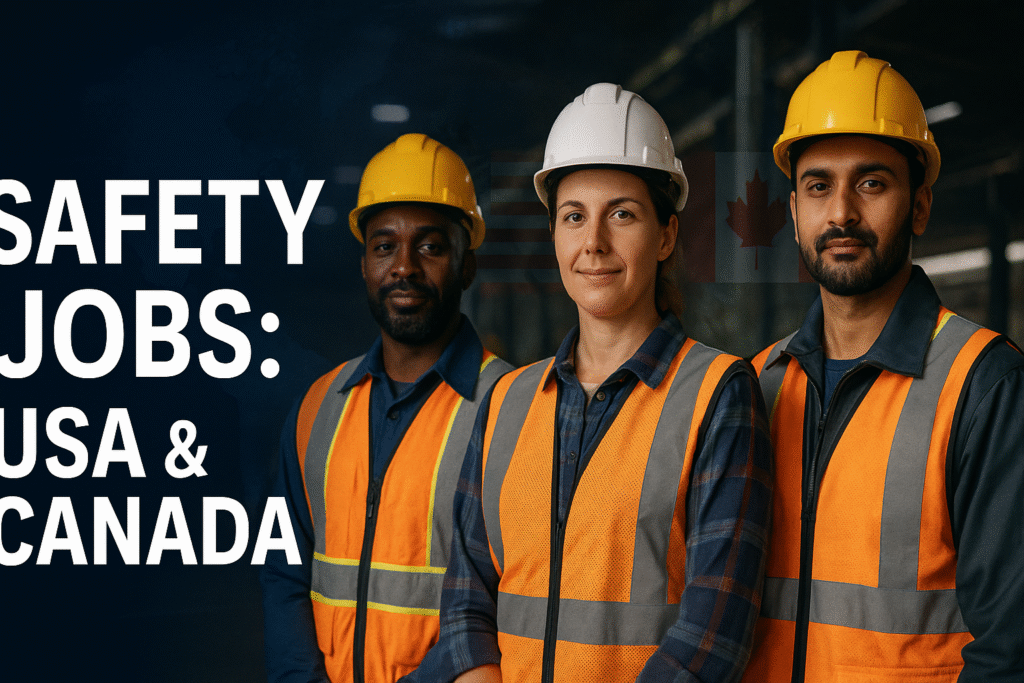Safety Jobs in USA and Canada are within reach if you approach your search like a professional project: define the scope (target roles and locations), collect the right credentials, build evidence of results, and execute a disciplined search plan.
Below is a practical roadmap you can apply this week—whether you’re aiming for your first coordinator role, stepping up to specialist/manager, or positioning yourself for international jobs in safety.
- What employers expect for Safety Jobs in USA and Canada
- Map your credentials to Safety Jobs in USA and Canada
- Resume tips for Safety Jobs in USA and Canada
- Targeted search strategy for Safety Jobs in USA and Canada
- Credential planning: your 6-month action plan
- Immigration basics for international applicants
- Interview preparation for Safety Jobs in USA and Canada
- Portfolio and proof: make your work visible
- Where international jobs in safety appear
- Common mistakes that stall offers
- Your next three moves (start today)
What employers expect for Safety Jobs in USA and Canada
Hiring managers consistently look for three things: proof you can control risk, proof you can influence people, and proof you understand the local regulatory landscape.
For US roles, many employers value completion cards from the OSHA 10/30 Outreach Training—useful as baseline hazard awareness (and required by some jurisdictions/employers), though not a “license.” OSHA

In Canada, employers often screen for national credentials such as CRSP® (Canadian Registered Safety Professional) as a benchmark of competence across education, experience, and exam performance. BoCRSP
Across both countries, managers want evidence that you can diagnose risk, implement controls, verify effectiveness with leading/lagging indicators, and communicate persuasively with frontline teams and executives. Build your pitch—and your resume—around those outcomes.
Quick internal reads to help: Safety resume template, Interview questions for safety roles, and USA vs Canada safety credentials.
Map your credentials to Safety Jobs in USA and Canada

A targeted credential plan separates strong candidates from the pack. Prioritize what aligns with your near-term goals and region.
United States: credentials that open doors
- OSHA Outreach Training (10/30-hour). Foundational awareness courses delivered by OSHA-authorized trainers; useful for entry and mid-level roles and sometimes specified by contractors or municipalities. OSHA
- BCSP certifications. The CSP® (Certified Safety Professional) is the widely recognized “gold standard” in the US safety profession; ensure you meet eligibility and plan your exam timeline. BCSP+1
Canada: credentials employers recognize
- CRSP® (via BCRSP). A national benchmark credential signaling verified education, experience, and examination against Canadian practice expectations. Review eligibility and the application/exam path. BoCRSP+1
International mobility boosters
- NEBOSH International General Certificate (IGC). A globally respected stepping stone for those targeting multinational employers or postings in the Middle East, Africa, and Asia. NEBOSH
Canadian readers often follow CCOHS resources and industry commentary from OHSE.ca to stay current on Canadian practice and trends.
Resume tips for Safety Jobs in USA and Canada
Make your resume read like a safety performance report—concise, quantified, and aligned to the job ad.
- Lead with role-matched outcomes. “Reduced TRIR 28% in 12 months by engineering substitution for solvent-based parts washer; eliminated 3 recordables and $120k in waste-handling costs.”
- Translate certifications into value. Instead of listing acronyms, add a five-word impact tag: “CSP® — systems-level risk leadership”; “CRSP® — Canadian regulatory depth.”
- Show system thinking. Mention frameworks you used (hierarchy of controls, bow-tie analysis, ISO 45001 gap closures) and the measurable results.
- Keep it two pages. Use one page if you’re early career.
Add an internal call-to-action like: Download our safety resume checklist.

Targeted search strategy for Safety Jobs in USA and Canada
Treat your job search like a high-risk task with a plan, controls, and verification.
- Define your target: Choose 10–15 employers across construction, manufacturing, logistics, healthcare, or energy.
- Reverse-engineer requirements: Build a simple matrix of job ads vs. your evidence (certs, projects, numbers).
- Network where hiring happens: Attend toolbox talks as a guest, local safety council events, and standards committee meetings. Follow EHS leaders on LinkedIn; comment with value (e.g., share a brief bow-tie on a timely risk).
- Apply with intent: Tailor two strong applications daily—not twenty generic ones.
- Track and improve: After each interview, note questions that stumped you; prepare crisp 60-second stories (“situation-action-result”) for next time.
When you’re ready, check your local listings on our Safety Jobs Board and add employers to your tracker.
Credential planning: your 6-month action plan
Month 1–2: Book OSHA 10/30 (US) or start CRSP® eligibility mapping (Canada). Months 2–4: Sit your first credential exam (NEBOSH IGC for global mobility or BCSP associate path if eligible).

Months 3–6: Build a portfolio of three measurable projects (incident trend reversal, machine guarding upgrade, or confined-space program refresh), each with a chart and one-page brief. Re-write your resume and LinkedIn around those wins.
- OSHA training: Plan with an OSHA-authorized provider; verify legitimacy and avoid card fraud. OSHA
- CSP® path: Confirm eligibility and exam window through BCSP before booking. BCSP
- CRSP® path: Review eligibility and the BCRSP examination process; map any gaps in education/professional development. BoCRSP+1
Immigration basics for international applicants
This is not legal advice; always consult official government sources or an immigration professional.
- Canada: Most foreign nationals need a work permit (employer-specific or open) before starting work in Canada; review IRCC’s guidance to determine the correct permit type and process. Canada.ca
- United States: Employers typically require authorization to work (citizenship, permanent residence, or an appropriate temporary status). For up-to-date options, review official US government resources (e.g., USCIS) and discuss with qualified counsel.

Tip: If you’re already in North America on a study or temporary status, align internships/co-ops with your target industry now; many full-time hires grow from placements.
Interview preparation for Safety Jobs in USA and Canada
Expect scenario-based questions that test how you balance compliance, practicality, and culture:
- Regulatory change: “A new silica rule goes into effect next quarter; outline your compliance plan for a 400-employee precast plant.”
- Behavior change: “Recordable hand injuries are flat despite PPE. What’s your hypothesis and first 30 days?”
- Conflicting pressures: “Production wants to bypass a light curtain temporarily to meet a rush order. How do you respond?”
Arrive with three case stories (incident reduction, audit to corrective action, and leadership coaching) and one failure story where you course-corrected.
For more prep, see our safety interview questions.
Portfolio and proof: make your work visible
Create a private, share-on-request folder containing:
- One-page case briefs (before/after KPIs; photos redacted).
- A dashboard snapshot (leading/lagging indicators; sample Gemba checklist).
- A training micro-lesson (5 slides max) you built for lockout-tagout or confined spaces.
Your goal is to demonstrate you don’t just “know safety”—you create safer systems.
Where international jobs in safety appear
Multinationals, EPCs, data centers, renewable energy, ports, and mining often recruit across borders.
If you’re targeting the Middle East, Africa, or Asia, NEBOSH IGC plus strong implementation evidence travels well and signals baseline competence to global employers. NEBOSH

Pair that with a risk-leadership narrative: e.g., “Scaled contractor safety program from 5 to 32 vendors, achieved 0.49 TRIR with 1.2M hours.”
Common mistakes that stall offers
- Credential mismatch. Applying in Canada without a CRSP® plan or in the US without a BCSP pathway makes you easy to pass over. BoCRSP+1
- Duty-based resumes. Listing tasks instead of verified outcomes (“reduced confined-space entries 37% through engineering change”).
- Regulatory vagueness. Saying “familiar with OSHA/Canadian OHS laws” without naming specific parts, standards, or the control strategy you executed.
- No stakeholder proof. Failing to show how you moved supervisors and trades from compliance fatigue to ownership.
Your next three moves (start today)
- Choose your lane (construction, manufacturing, healthcare, logistics, energy).
- Book your next credential (OSHA 10/30; CSP® pathway; or CRSP® eligibility review). OSHA+2BCSP+2
- Ship one portfolio case within two weeks (pick a real improvement, quantify, and package it).
Round out your learning with reputable sources like OSHA’s training pages, BCSP, BCRSP, NEBOSH, and Canadian-focused articles from CCOHS and OHSE.ca (for ongoing context and case studies). NEBOSH+3OSHA+3BCSP+3

If you follow this blueprint—credentials aligned to the market, quantified results front and center, a disciplined search cadence, and a compelling portfolio—you’ll stand out quickly for Safety Jobs in USA and Canada.

No comments yet